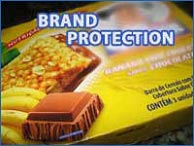Brand Security
"New Trends in Security Packaging"

Packagers
cannot be too careful these days. In times of bioterrorism, tampering,
counterfeiting and shoplifting, no area is immune from these brand-damaging,
sales-sapping activities.
Fortunately, there are steps they can take to protect their products from
harm and keep brand equity intact. Several innovative advancements designed
to counter threats to brands and consumers are available in the market.
Brand Security Seals
Sealed packaging provides protection against a myriad of hazards, including
tampering, counterfeiting or pilfering, and many counter more than one
problem at the same time. One of the most familiar sealing methods is shrink
film applied as a wrap, band or full-body sleeve, which generally consists
of unprinted or printed polyvinyl chloride, oriented polystyrene or
polyethylene terephthalate glycol film.
Sleeves run from the base of containers to the top of closures and
typically are vividly printed in eight or more colors to perform double duty
as product labels. This design enhances shelf appeal by providing a 360
drgree surface for graphics. Shrink bands, which generally cover closures,
are often custom-colored or printed with logos or other messages to make
duplication more difficult.
There are two schools of thought as to whether bands should be difficult or
easy to remove. Some companies feel a band that is difficult to remove
provides a greater level of confidence that the product has not been
touched. However, if a packager wants an easy-opening option, bands can be
perforated or tabbed. It should be noted the perforated design can enhance
tamper evidence by increasing the band's fragility to the point that it
disintegrates upon removal so it is impossible to reposition it around the
cap.
Induction sealing
Induction sealing uses an electromagnetic field to adhere a membrane to
container openings at speeds of up to 800 per minute. The resulting hermetic
seal not only provides tamper evidence, but also prevents leaks, protects
product freshness and deters pilferage.
Sealing is accomplished by passing capped containers under an
electromagnetic sealing head which generates heat to release the membrane
seal from the closure liner and adhere it to the lip (land area) of the
bottle.
Clamshell packaging
Sealed clamshells combine tamper evidence with pilfer resistance. Designed
as a less expensive alternative to radio frequency (RF)-sealed clamshells,
the paperboard/film structure deters pilferage and they also reinforce
die-cut holes so heavier items can be merchandised on hanging displays. For
added security, you can add an electronic article surveillance (EAS) tag
inside the clamshell.
RF-sealed clamshells and their attractive, indestructible seals have proven
very attractive to retailers, resulting in interest by consumer products
companies.
 Holographic distinction
Holographic distinction
Holographic materials are ideal for security packaging. Not only do
holograms offer a distinctive appearance with shifting colors and patterns,
but the production process presents a barrier to counterfeiters because it
requires specialized equipment and is relatively expensive.
Future security
Technology continues to evolve to stay one step ahead of counterfeiters.
One promising possibility under development is microstructure mapping. This
involves identifying the physical structure on an atomic level of any
specific object - packaging or product - and a database of information about
the item. The result is a new tool to counter diversion since diverters
typically strip off all identifying information.


 Packagers
cannot be too careful these days. In times of bioterrorism, tampering,
counterfeiting and shoplifting, no area is immune from these brand-damaging,
sales-sapping activities.
Packagers
cannot be too careful these days. In times of bioterrorism, tampering,
counterfeiting and shoplifting, no area is immune from these brand-damaging,
sales-sapping activities. 